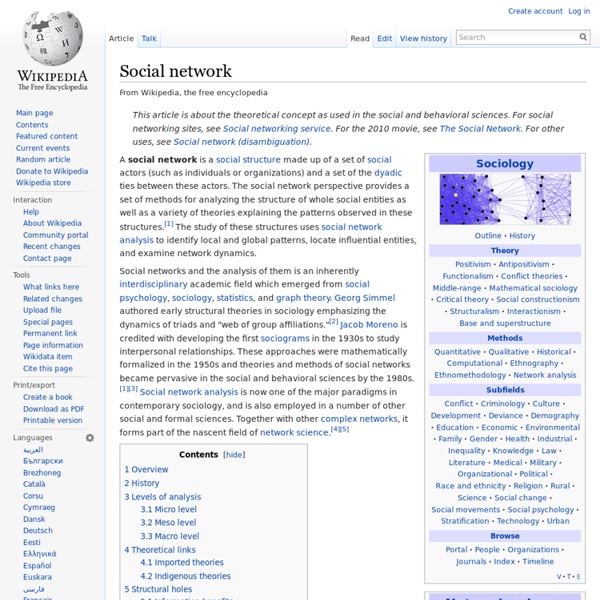Social network

http://en.wikipedia.org/wiki/Social_network
Related: Social Networking
How to Become a Master at Networking
Humans are social creatures. We thrive by helping each other grow. Nearly everything you accomplish is a result of the people you spend time with. From sharing information about new opportunities to playing an influential role in your personal development, your network – every person you know – is there supporting you along the way.
Category:Social networking services
From Wikipedia, the free encyclopedia Subcategories This category has the following 20 subcategories, out of 20 total.
Steve Jobs Resigns As CEO Of Apple
Title says it all. More to come. For now, the letter from Steve Jobs himself: To the Apple Board of Directors and the Apple Community:I have always said if there ever came a day when I could no longer meet my duties and expectations as Apple’s CEO, I would be the first to let you know. Unfortunately, that day has come.I hereby resign as CEO of Apple. I would like to serve, if the Board sees fit, as Chairman of the Board, director and Apple employee.As far as my successor goes, I strongly recommend that we execute our succession plan and name Tim Cook as CEO of Apple.I believe Apple’s brightest and most innovative days are ahead of it.
Social Network Analysis: An Introduction by Orgnet,LLC
Social network analysis [SNA] is the mapping and measuring of relationships and flows between people, groups, organizations, computers, URLs, and other connected information/knowledge entities. The nodes in the network are the people and groups while the links show relationships or flows between the nodes. SNA provides both a visual and a mathematical analysis of human relationships. Management consultants use this methodology with their business clients and call it Organizational Network Analysis [ONA].
How to Bond
Do you have someone in your life that you really want to connect to but aren’t sure how? I want to give you some tools that will help you optimize your relationships and go from: Stranger to AcquaintanceColleagues to FriendsBuddy to ConfidantCrush to DateFriend to Best Friend.
10 Ways To Rock A Networking Event
Imagine this: You’ve just walked into a crowded room full of strangers. Your mission is to meet new people, make friends or pass out business cards. Go! This used to be my mission (and nightmare) every time I had to go to a networking event, party or group get together—and I would always end up wondering, “Why did I even come to this thing?” Networking events suck. Parties full of strangers suck.
Web 2.0
Herkunft[Bearbeiten] “An increase of outsourcing with web services is nothing less than the start of what Scott Dietzen, CTO of BEA Systems, calls the Web 2.0, where the Web becomes a universal, standards-based integration platform. Web 1.0 (HTTP, TCP/IP and HTML) is the core of enterprise infrastructure.”
7 Networking Hacks to Connect Better at Your Next Conference
Whether you have a job that entails regular conferences or you’re a freelancer who gets to work like a hermit, you’ll probably need to network at some point in your life. Here’s how to do it so everyone you touch gains from the experience. It’s an indisputable fact that personal contacts open doors. One classic study, outlined in the book Getting a Job, showed that among the 282 men surveyed, 56 percent had found their jobs through personal contacts, whereas only 19 percent had found theirs through job advertisements and 10 percent through applications of their own initiative. What have we learned here?
Related:



